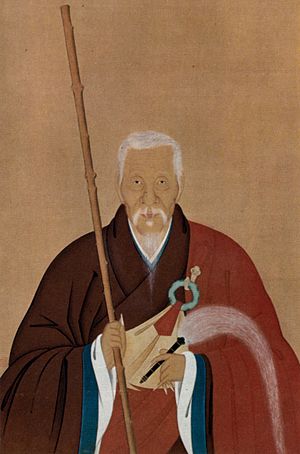Ingen facts for kids
Quick facts for kids Ingen Ryūki |
|
|---|---|
| Yinyuan Longqi | |

Portrait of Ingen Ryūki from 1671
|
|
| Religion | Buddhism |
| School | Chan |
| Lineage | Linji school |
| Personal | |
| Born | Lin Zengbing December 7, 1592 Fuqing, Fujian, China |
| Died | May 19, 1673 (aged 80) Uji, Kyōto, Japan |
Ingen Ryūki (born December 7, 1592 – died May 19, 1673) was a famous Chinese poet, calligrapher, and Buddhist monk. He belonged to the Linji school of Chan Buddhism in China. He is best known for starting the Ōbaku school of Zen in Japan.
Contents
Ingen's Early Life and Training
Ingen was born on December 7, 1592, in Fuqing, Fujian, China. This was during the time of China's Ming dynasty. When Ingen was only five years old, his father disappeared.
At age 20, Ingen went looking for his father. He traveled to Mount Putuo off the coast of Zhejiang province. There, he helped by serving tea to monks.
When he was 28, his mother passed away. After this, he became a monk at his family's temple. This temple was called Wanfu Temple on Mount Huangbo in Fujian.
Becoming a Monk and Abbot
Ingen learned from two important teachers at Wanfu Temple. Their names were Miyun Yuanwu and Feiyin Tongrong. In 1633, he received "dharma transmission" from Feiyin Tongrong. This meant he was recognized as a true master of Buddhist teachings.
In 1637, Ingen served his first term as the abbot of the temple. An abbot is the head monk of a monastery. He served a second term starting in 1646. During this time, he helped Mount Huangbo become a very busy and important Buddhist center.
Moving to Japan and Founding a School
In 1654, a Japanese monk named Itsunen Shoyu asked Ingen many times to come to Japan. Ingen finally agreed and traveled to Nagasaki, Japan. He went with about 30 other monks and skilled artisans. One of his students, Muyan, also came with him.
In Japan, Ingen started a new branch of Zen Buddhism. It was called the Ōbaku school of Zen. In 1661, he built the main temple for this school. It was named Manpuku-ji and was located in Uji, Kyoto.
Ingen Ryūki passed away at Manpuku-ji on May 19, 1673.
Calligraphy Skills
Ingen was a very talented calligrapher. Calligraphy is the art of beautiful handwriting. He brought the Ming style of Chinese calligraphy to Japan.
He was known as one of the Ōbaku no Sanpitsu. This means "Three Brushes of Ōbaku." The other two "brushes" were his students, Muyan and Sokuhi Nyoitsu. He also brought paintings by the artist Chen Xian with him to Japan.
Ingen's Writings
Ingen wrote many books and papers. His published works include 35 different titles. These works have been printed in 46 publications and 4 languages. Many libraries around the world have his writings.
- 1979 — Complete Works of Ingen (新纂校訂隱元全集, Shinsan kōtei Ingen zenshū, OCLC 019817244)
See also
 In Spanish: Ingen Ryūki para niños
In Spanish: Ingen Ryūki para niños

